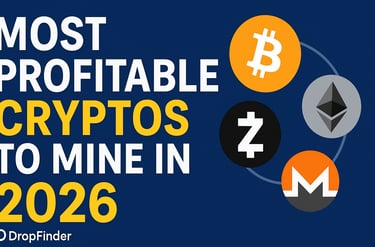The Most Profitable Cryptos to Mine in 2026 — Strategy, Trends & DropFinder Insights
Discover which cryptocurrencies are expected to offer the highest mining profits in 2026. Learn about hardware, energy, mining models, risks and how DropFinder (airdrop & new-token tracker) can help spot opportunities early.
CRYPTO NEWS
10/10/20257 min read
Introduction
The crypto mining landscape has evolved faster than most people expected. What once started as a hobby using CPUs and GPUs has now become a global industry worth billions of dollars. Yet, mining in 2026 isn’t as simple as plugging in a machine and printing money. Profitability depends on a delicate balance between hardware, electricity rates, token prices, network difficulty, and timing.
Still, there are huge opportunities if you understand which coins have staying power and which new projects are worth exploring early. The goal of this article is to help you identify the most profitable cryptos to mine in 2026, what strategies actually work, and how tools like DropFinder — a platform for tracking airdrops and new token launches — can help you find hidden gems before they explode.
Understanding What Makes Mining Profitable
Mining profitability is not just about which coin you choose — it’s about your overall setup and timing. Your mining income can be estimated with a simple idea:
Your share of the network × block reward × coin price – electricity and hardware costs.
Every factor matters:
The price of the coin you’re mining
Your electricity rate
The hashrate (network competition)
The efficiency of your ASIC or GPU hardware
Cooling, maintenance, and operational expenses
By 2026, miners must think more strategically than ever. Electricity costs vary by country. Hardware depreciates quickly as newer, more efficient ASICs arrive. Network difficulty rises as more miners join.
The key to survival is optimization — using the right equipment, the right power source, and even exploring new coins early before difficulty skyrockets. That’s where DropFinder becomes useful, as it tracks brand-new crypto projects, some of which start with proof-of-work (PoW) mining or hybrid mechanisms that reward early adopters generously.
How Mining Economics Are Changing in 2026
Several shifts are reshaping crypto mining:
Energy efficiency is everything.
The new generation of ASICs in 2026 are drastically more efficient, consuming half the electricity per terahash compared to 2023 machines.Renewable energy is becoming essential.
Miners are moving toward hydroelectric, geothermal, or solar-based energy sources to reduce operational costs and avoid regulatory pressure.Decentralization is returning.
GPU mining is seeing a quiet comeback through altcoins and privacy coins that resist ASIC domination.New hybrid models are emerging.
Some projects are combining PoW and PoS to create more balanced ecosystems. These new chains often launch with a mining phase to distribute tokens — perfect opportunities for early miners and users of DropFinder to get in early.Regulatory clarity is improving.
Governments are beginning to differentiate between sustainable mining operations and high-impact, unregulated setups. Miners who adapt early will benefit.
Most Profitable Cryptos to Mine in 2026
Let’s explore which cryptocurrencies are expected to deliver the best mining profits in 2026 based on current technology and projected market trends.
Bitcoin (BTC)
Bitcoin will remain the cornerstone of crypto mining. Despite reduced block rewards after the 2024 halving, Bitcoin mining will still be profitable for those with access to cheap electricity and efficient ASIC hardware.
Advanced miners are now using units like the Antminer S21 Pro and Whatsminer M60S, capable of producing massive hashrate at under 15 joules per terahash. This makes operations viable even at lower margins.
However, casual or small-scale miners will struggle to compete. The Bitcoin network’s difficulty continues to climb, and margins are thin. Only those with bulk power deals, industrial setups, or renewable sources can maintain solid returns.
Verdict: Bitcoin remains profitable in 2026, but primarily for professional operations or miners with power costs under $0.04 per kWh.
Ethereum Classic (ETC)
When Ethereum switched to Proof of Stake, miners migrated to Ethereum Classic — and that momentum continues. ETC still supports GPU mining and offers a stable ecosystem with reasonable liquidity.
The main reason ETC remains profitable is accessibility. You can use older GPUs, join mining pools, and still earn steady rewards. Unlike Bitcoin, you don’t need high-end ASICs.
In 2026, ETC could see renewed interest if Layer 2 scaling and cross-chain compatibility improve. As long as demand holds and difficulty remains moderate, GPU miners can continue to make profit.
Verdict: A great choice for GPU miners looking for reliability and lower competition.
Monero (XMR)
Monero continues to be one of the most privacy-centric cryptocurrencies and maintains its ASIC-resistant RandomX algorithm. This means anyone with a decent CPU or GPU can mine XMR without massive investment.
Its decentralized nature and focus on privacy attract a dedicated user base, keeping price stability reasonable. For solo miners or small-scale operators, Monero provides one of the most balanced mining ecosystems in 2026.
Verdict: Ideal for individuals who prefer CPU mining and want consistent, low-cost participation in the mining economy.
Zcash (ZEC)
Zcash remains relevant thanks to its privacy features and Equihash algorithm. It can still be mined using GPUs and remains accessible to mid-range miners.
While ZEC’s market performance has fluctuated, its continued focus on zero-knowledge technology keeps it on investors’ radar. The mining difficulty is lower than Bitcoin or ETC, which could make it profitable in specific regions where electricity is cheap.
Verdict: A good alternative for miners seeking moderate profitability and accessibility with GPUs.
New and Emerging PoW Chains
The future may not lie in established coins alone. Every year, new proof-of-work projects launch with attractive block rewards and low difficulty at the start. Early miners who join these chains can earn exponentially higher returns before the masses catch on.
Here’s where DropFinder comes into play. It constantly tracks new token launches, airdrops, and emerging PoW chains that often begin with huge incentives for miners. By joining early, you can mine thousands of tokens while difficulty is low — and if the project gains traction, those early tokens can become extremely valuable.
Verdict: The biggest profits in 2026 may come from early mining of new PoW coins spotted through DropFinder before they trend.
The Role of Energy and Location
Energy cost will define who wins or loses in 2026 mining. Access to renewable or subsidized energy sources can make the difference between profit and loss.
Many miners are relocating to countries like Paraguay, Iceland, Kazakhstan, and regions in India with abundant hydropower. These regions offer electricity rates up to 70% cheaper than global averages.
Miners in hot climates are turning to immersion cooling or hybrid systems that reuse waste heat. Every watt saved increases your net income.
So before you choose a coin to mine, ensure your energy rate is sustainable. Even the most efficient ASICs can’t overcome high power bills.
Using DropFinder to Gain a Strategic Edge
Mining is about staying early and informed. That’s where DropFinder becomes a secret weapon.
DropFinder is a crypto opportunity tracker that lists new airdrops, ICOs, and blockchain projects. While it’s known for helping users find free token rewards, it also indirectly supports miners in discovering emerging PoW projects before they become mainstream.
Here’s how DropFinder can help miners in 2026:
Spot new mineable coins early. Many upcoming projects still launch with mining-based token distribution. DropFinder helps identify them quickly.
Earn tokens through testnets and airdrops. If you’re testing a PoW network before launch, you may earn tokens that later gain market value — similar to mining rewards but without energy costs.
Diversify your earnings. Instead of relying solely on mined coins, you can combine mining profits with airdrop rewards to stabilize income.
Reduce exposure to market volatility. New token rewards often provide a hedge during bearish mining periods.
In short, miners who use DropFinder are more likely to catch early opportunities before difficulty skyrockets or mainstream miners arrive.
Crafting a Smart Mining Strategy for 2026
A winning strategy in 2026 will require adaptability and diversification. Here’s how to structure your approach:
Maintain a dual setup. Use ASICs for Bitcoin and high-cap coins while keeping GPU rigs ready for ETC, ZEC, or new PoW launches.
Follow real-time profitability data. Use mining calculators and compare returns daily. Shift rigs when necessary.
Secure low-cost energy. Whether it’s solar, hydro, or local subsidy, cheaper energy equals higher margins.
Leverage DropFinder for scouting. Track every new mineable project or token distribution to stay one step ahead.
Plan for hardware upgrades. Don’t let outdated machines eat your margins — sell or repurpose them early.
Stay compliant and sustainable. Governments are watching energy use closely. Mining with renewables not only lowers costs but protects you from sudden policy changes.
Expected Profit Scenarios in 2026
While exact numbers will depend on electricity rates and token prices, we can predict general trends.
Large-scale Bitcoin operations using efficient ASICs in low-cost regions may still earn between 15% and 30% annual ROI, assuming stable BTC prices.
GPU miners focusing on Ethereum Classic, Zcash, or similar coins may see 10% to 20% margins if they can manage electricity costs effectively.
Solo miners or hobbyists using CPUs for Monero may earn modest but steady returns, with the benefit of full decentralization.
Miners who explore early PoW chains through DropFinder could potentially earn 5x–10x higher returns initially — though with higher risk.
Diversifying across these categories gives you the best balance of reward and stability.
Risks to Consider
No mining discussion is complete without acknowledging the risks involved:
Token price crashes. If your coin drops 50%, profits vanish instantly.
Rising network difficulty. As more miners join, individual rewards decline.
Regulatory crackdowns. Governments could impose taxes or energy restrictions.
Hardware failure or obsolescence. New ASIC generations can quickly make old machines worthless.
Project failure. New coins discovered through DropFinder might not survive long-term.
The solution is awareness. Keep monitoring market conditions and never overextend financially on a single coin or machine type.
The Future of Mining: Integration with Web3 and Airdrops
The lines between mining, staking, and airdrops are starting to blur. Many blockchains now include hybrid reward systems that encourage users to perform useful work, run nodes, or hold tokens — all of which resemble mining in some way.
By using platforms like DropFinder, miners can expand their income streams into this new territory. Instead of relying solely on PoW rewards, you can combine:
Traditional mining income
Token airdrops from testnets
Node operation rewards
Early staking bonuses
This approach not only maximizes earnings but also future-proofs your participation as the crypto economy evolves beyond pure mining.
Final Thoughts and Recommendations
The mining landscape in 2026 will be more competitive, more efficient, and more interconnected than ever before. Profitability will depend less on luck and more on smart strategy.
Bitcoin will remain the king for industrial miners. Ethereum Classic, Zcash, and Monero will continue serving small to medium miners. But the biggest growth may come from new PoW projects that appear out of nowhere — exactly the kind that DropFinder helps you discover early.
If you’re planning to mine in 2026:
Focus on energy efficiency first.
Diversify across coins and new launches.
Track early-stage opportunities through DropFinder.
Be ready to pivot when difficulty or price changes.
Avoid emotional decision-making — always calculate real ROI.
Mining is no longer about guessing; it’s about precision. Those who combine data, energy efficiency, and early discovery will dominate 2026’s mining ecosystem.
And remember, while mining can be profitable, it’s just one piece of the evolving crypto puzzle. Pair it with smart research tools like DropFinder, and you’ll always be one step ahead in identifying the next wave of opportunities.




